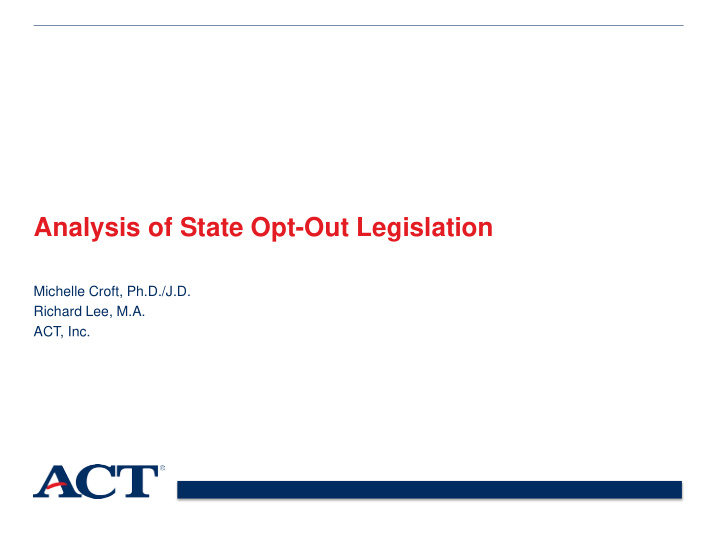



Analysis of State Opt-Out Legislation Michelle Croft, Ph.D./J.D. Richard Lee, M.A. ACT, Inc.
Background • Spring 2015 – 12 states failed to meet ESEA 95% participation requirements • Reasons for opting out – Curriculum – Accountability use of scores – Cut score placement – Tests (length, quantity, administration mode) – Usefulness of information • Public opinion – Slight majority support requiring participation 2
Why are opt outs problematic? • Possible implications to validity of test scores • Federal funding – ESEA required 95% participation—automatically identified as failing. – ESSA requires 95% participation—states must incorporate into accountability system. – ESSA Draft Regulations • Require states to take actions for schools missing participation requirement – USDOE Dec. 2015 letter to states: • States with low participation rates need to develop opt- out action plan. 3
Purpose 1. Identify existing opt-out laws 2. Identify and analyze legislation introduced in 2015-2016 4
Method • Existing Legislation – National Association of State Boards of Education 2015 report • Introduced Legislation – CQ StateTrack – 2015: general assessment terms • Updated using NCSL’s College & Career Readiness Standards Legislation Dashboard – 2016: opt-out specific search • “opt out” w/200 assessment, “opt out” w/200 parent • Similar searches using “excuse” and “refuse” – Bills filed prior to June 1, 2016 5
2015 Opt-Out Laws 6
2015-2016 Legislation • 87 bills filed—65 unique • Enacted opt-out legislation: – 4 states in 2015 and 1 state in 2016 – 2 states enacted opt-out related bills but did not authorize opt-outs Note: Alaska and Hawaii are not pictured. Alaska had a set of companion bills introduced in 2015. Hawaii had three sets of companion bills introduced in 2015 and one set of resolutions in 2016. 7
Themes • Process • What happens during testing • Consequences – Students – Schools 8
Opt-Out Process 9
Parent Notification • General notification – 19 bills in 12 states – Assessment information and right to opt out – Incentives for testing (WA S.B. 6474) • Time frame for notification – Varied from start of school year and again prior to testing (MO H.B. 2315) to 1-2 weeks prior to testing (NY A.B. 6025/S.B. 4161) 10
Forms • General – 17 bills in 12 states – Most had state department of education create form (n=11) • 3 included the form language in the bill • Differences in required form content – Right to excuse along with the value of the assessment (OR H.B. 2655) – No disciplinary actions or effect on academic record (RI S.B. 736) 11
What happens during testing? • 18 bills required educational activities. • Some defined “meaningful activities” – SC H.B. 4330 “promote academic and intellectual growth” • Test security implications – Addressed in NJ and GA 12
Consequences for Students • LEA-developed alternative – “Sufficient” (AZ H.B. 2246) – “Comparable” (WA H.B. 2167) – “Not more rigorous” (UT H.B. 164) • Not exempt from local requirements (NJ A.B. 4165/S.B. 2767 and ND H.B. 1283) 13
Consequences for the School • Reporting – Prevent negative impacts (UT S.B. 204) – Not include testing refusals in calculations (OH H.B. 420) – Notations on school report card (OR H.B. 2644) • Maintaining data – Only three sets of bills required maintenance 14
Conclusion • Legislation indicates move towards formalizing process and removing consequences • Practical issues: – How to provide alternative educational activities? – How to create comparable alternatives for graduation and promotion? – How to comply with ESSA requirements? • Validity implications in public reporting – Particularly when there are not requirements to track opt outs • Communicating (and ensuring) value of assessments for stakeholders 15
Recommend
More recommend